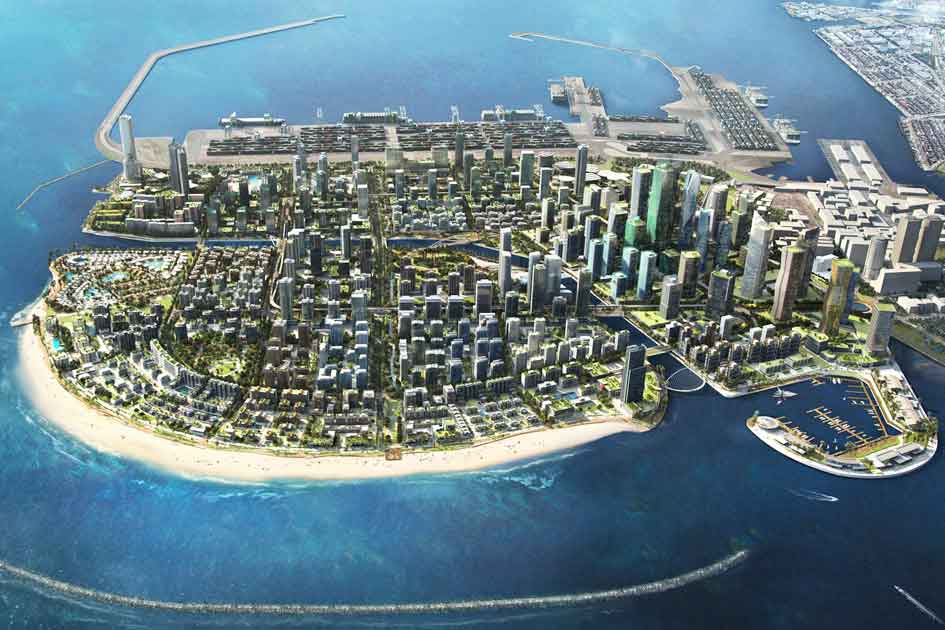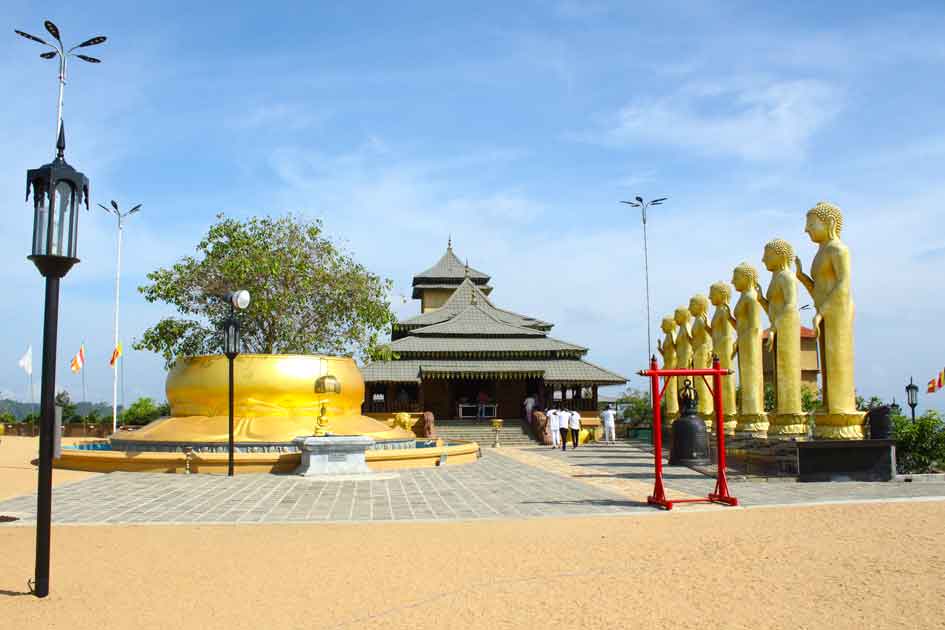Port City Colombo
Port City Colombo is a 269-hectare sea reclamation city construction project developed by CHEC Port City Colombo (pvt) Ltd as an expansion of the current Colombo CBD.
Port City Colombo is a brand new city creation designed as an expansion of Sri Lanka's thriving commercial hub, Colombo's, Central Business District. Port City Colombo will be South Asia's premier residential, shopping, and industry destination, spanning 269 hectares of reclaimed sea land and offering unrivaled developed city living along the warm waters of the Indian Ocean. The Financial District, Central Park Living, Island Living, The Marina, and International Island will be among the five precincts in the development.
Port City Colombo Completion Date
Port City Colombo, when completed, will have over 5.6 million square meters of building area, boasting the latest of architecture and standards. Its lifestyle and business services will include world-class amenities and spaces in Healthcare, Education, Entertainment, Hotels and Restaurants, Retail, and Office, as well as an Integrated Resort and a Marina, which will include the latest in seaside living. Port City Colombo will be the most livable city in South Asia, based on the most recent sustainable city designs and smart city principles.
Philosophy of Port City Colombo
The goal of Port City, Colombo (PCC) is to set the standard for environmental friendliness and sustainability. A location where ecologically conscious residents, businesses, and tourists will want to live and conduct business. It will be a site where both residents and visitors will be able to practice ecologically beneficial behaviors. To serve as a showcase metropolis for the rest of the globe.
It will be a green city with parks, open spaces, and rivers. A city with strong public transportation choices and a layout that encourages walking and cycling will alleviate the problems caused by excessive traffic. It will be a city with green roofs, car parks with sufficient tree shade, and sustainable energy. It will be a city that promotes a healthy and sustainable lifestyle for all of its residents, both human and animal.
Sustainable Development of Port City Colombo
In keeping with its goal to create a totally sustainable city that extends beyond our scope as a master developer, PCC intends to include sustainability criteria for third-party developers to follow while building their own parcels of land.
PCC will be a contemporary city where the architecture and amenities make it simple to live a sustainable lifestyle without sacrificing the level of services provided.
Sustainability of Port City Colombo
Port City, Colombo (PCC) has adopted an integrated strategy for energy, water, and waste management in order to achieve long-term environmental sustainability and a pleasant atmosphere for its inhabitants.
Despite a heavily built city center, Colombo has retained a "green character." The city's notable sites include Galle Face Beach, Beira Lake, and Viharamabedevi Park. Future pedestrian and transportation improvements will connect these regions to the Fort and PCC development.
The planned zipper green system is an efficient method of integrating the new and current central business districts (CBDs) while also creating a pedestrian-friendly environment. This opens up possibilities for developing an internal green and blue system that will connect walkers and bicycles in the future Colombo City Centre.
The overarching objective is to lessen the negative environmental effect. The city's emissions of greenhouse gases and pollutants to the air and sea will be reduced by prioritizing pedestrian and bicycle transportation design.
Water resources must be safeguarded and maintained for current and future generations via effective water management. Through a rainwater collection technique, PCC will reduce the amount of potable water used for irrigation. For stormwater collection, low-impact development methods are used across the city.
The waste separation that works well will minimize the demand for sanitary landfill areas as well as the cost of landfill construction and management. PCC expects that through implementing waste management best practices, it will be able to decrease the environmental effect of trash disposal, reduce greenhouse gas emissions from open dumps, and improve health conditions.
Investment Opportunities of Port City Colombo
"Port City Colombo has been selected as a significant project for the Central Business District and the Colombo Metro Area" (CMA). The Port City Master Plan for the 269.3 hectares of recovered land was completed in 2014. The concept seeks to create and construct a new world-leading city development based on the best worldwide experience, specifically tailored to the Sri Lankan context and site-specific circumstances. The new city will draw on the region's and environment's inherent characteristics to create an ideal modern community for business, living, and recreation.
The COLOMBO PORT CITY All-inclusive strategy will incorporate itemized land-use guidelines and improvement control guidelines (DCR) to guarantee that all members in Colombo Port City advancement, including modelers, engineers, manufacturers, administrators, and architects, add to the acknowledgment of the ideal vision and character for the new city."
The IMF Report
The research examines 12 Western Hemisphere nations, two from the Middle East, and five from Southeast Asia. Asia is rising in the ranks, and this figure is expected to rise more in the next 20 years.
Can Sri Lanka make it into the list?
The answer to that fundamental issue is dependent on the policies that are implemented now in order for Sri Lanka to attain exponential development in 20 years. Sri Lanka might learn from other countries, such as Luxembourg (the world's wealthiest), how they attained prosperity.
What exactly does it mean to claim a country is 'wealthy,' especially in an era of rising economic inequality between rich and poor in modern society?
While Gross Domestic Product (GDP) represents the value of all products and services generated by a country, dividing total production by population is thought to indicate actual value rather than a fiscal statistic. A better method to determine how affluent or poor a country is would be to look at how the population is distributed in relation to one another, as well as the distribution per individual, per population.
The reasoning is based on the reality that certain tiny nations have an abundance of either highly qualified human capital or natural resources, as well as small populations. When you apply the above method to calculate the average standard of living, which takes into consideration inflation rates and the cost of local products and services, you obtain a more realistic picture of a country's average quality of life. The resulting value is known as Purchasing Power Parity (PPP), and it is frequently represented in US dollars to facilitate comparisons across nations.
Luxembourg success story
Luxembourg, with a population of 613,894, has been the wealthiest country in the world, per capita, with a highly trained population and a high quality of life for a number of years. Luxembourg transformed its economy from a resource-based to a sophisticated human capital investment economy by investing in its people. As a result, its financial industry has become a significant Financial Centre for huge private banks, and it is the largest contributor to its economy. Historically, the economy was mainly resource-based, with a concentration on coal exports and iron ore.
The discovery of large iron ore deposits in the mid-nineteenth century altered Luxembourg's fortunes almost immediately. Mines and factories sprung up, ushering in the country's wealthy steel sector. Luxembourg had become one of Europe's major steel manufacturers by the end of the nineteenth century.
Sri Lanka has the potential
This is where Sri Lanka's high literacy and educational attainment levels, which have continuously increased since the country's independence in 1948, might help. The current youth literacy rate is 97 percent. The administration has made strengthening the national education system and access to education a top goal.
The most valuable resource a country may have is its people or human capital, and if you can grow it, you can certainly become a significant player like the rest of the tiny nations.
Most industrialized nations have outperformed expectations in terms of human capital development; even the fact that many of these countries lack natural resources, such as mining or oil and gas, has not prevented them from reaching high levels of productivity and human development capital. Having a knowledgeable workforce provides you numerous alternatives, ranging from building a financial center of excellence to developing artificial intelligence and technology, all of which are critical for an economy's success.
Without a doubt, the current situation with the Coronavirus has an impact on every economy. As governments throughout the world have put their populations on lockdown, downloads of conference call applications have skyrocketed to all-time highs, and the firms behind them have seen their stock prices increase.
The remainder of the world's stock market is in financial distress. Because the Corona crisis has touched the whole globe, all economies are affected, and the repercussions are severe. This has changed the way most workers operate, rather than the traditional way of working from one's workplace.
Working from home has grown popular as a result of the Coronavirus. The majority of individuals have access to internet facilities where they may do their usual business utilizing Internet connectivity, just as they did when they worked from the office building.
Given the availability of high-speed Internet access, more individuals than ever are attempting to engage in and conduct business as usual through the usage of social media platforms and conferencing platforms. These and other things are completed that they would not have regarded usual. People are currently utilizing Zoom and other platforms on a regular basis.
The global market for conference call applications is anticipated to grow significantly from $7.87 billion in 2020 to $16.03 billion in 2021. The shift in growth is mostly due to the company's demand, which increased rapidly during the COVID-19 pandemic in 2020. The market is expected to grow considerably.
The conference call market comprises video conferencing software and related services provided by entities (organizations, sole proprietorships, and partnerships) that allow users in various places to have face-to-face meetings without having to relocate from one location to another. Video conferencing has the potential to improve performance, save time, reduce travel expenses, and enhance cooperation. The service-based video conferencing system is not restricted to deployment in the cloud or on-premises; by enterprise size into small and medium companies, big enterprises; or by end-use into corporate, education, media and entertainment, government and defense, and others.
Thinking outside the box
Countries and economies must begin to think outside the box in order to be successful; the old method of conducting business cannot be relied on as the sole standard. What was formerly uncommon or unorthodox, but now inventive, has become the standard, and we must adjust to our new surroundings of the 'New Normal.' We will not be successful until we continuously develop and evolve our technological know-how and people.
We must be the forerunners in this unique era of time, and Sri Lanka is presently at the head of such transition, with the current administration in place and a huge majority in Parliament. The government has devised a unique plan to relaunch the economy by hosting a big worldwide webcast to exhibit the best of what Sri Lanka has to offer to foreign investors.
Prior to the Coronavirus epidemic, governments and companies would spend a lot attending important conferences. Hosted in various regions of the globe, such as the World Economic Forum in Davos, and that sort of activity has ceased.
Port City Colombo Project
The goal is to compete with the finest in the world, and Sri Lanka's geographic position gives it a perfect climate for such a financial center. Because, when comparing current advancements in the Middle East, people's most common complaint is that it is cultureless, with a plethora of retail lanes, a lack of green habitats, and nothing else, surrounded by an unfriendly environment, and excessively hot in the summer months.
In comparison to Hong Kong, recent legislative changes and societal turmoil have forced big investors to reconsider operating from Hong Kong. As a result of this circumstance, several of the major institutions are searching for new locations to do their business.
The legal framework of Sri Lanka is quite close to English law, making it simple for international investors to participate and do business without too much problem, in contrast to certain regions of the world, such as the Middle East or the Far East, where things may be exceedingly tough.
Sri Lanka should be on the rankings list in a few years, especially with the brand-new infrastructure development, the Colombo International Financial City, which is a special economic zone and International Financial Centre. It is now being built on reclaimed ground close to the island's most iconic and prestigious real estate, the Galle Face Green. As of January 2018, the land reclamation work had been finished.
Port City Colombo is a 269-hectare new city development proposed as an extension of Colombo's present Central Business District. International Island, Island Living, Central Park Living, Financial District, and The Marina will be the five primary urban precincts or districts of the future metropolis.
International Island will be a commercial and recreational destination that will have a resort and theme park, a conference and exposition center, healthcare and education facilities, and a waterway park.
The Island Living neighborhood will have villa-style houses as well as public spaces such as Malwathu Park. A city beach will stretch along the district's southern border. Open blocks, public parks, and pavilions will be included in the Central Park Living zone.
The Financial District will include both Grade A office space and a retail destination. The Marina offers sea access as well as public parks and aquatic attractions.
Canal quays and boulevards will function as gathering places and views in all areas. A 3km-long offshore barrier protects the development from increasing sea levels and strong waves.
Sri Lanka was one of the principal nations on the planet to utilize innovation in a meeting video office to hold a worldwide online course Venture Gathering drawing in worldwide financial backer crowds, utilizing the above innovation that has made it workable for the crowd to partake without leaving their present area.
According to social media, the event has gone viral, with an oversubscription of investor participants from across the world who have expressed a strong interest in investing and considering Sri Lanka as a viable investment destination. Europe, America, Asia, and the Middle East have all expressed interest.
Sri Lanka the rising star
Sri Lanka has a developing economy and is one of Asia's emerging markets, making it an appealing investment location. Sri Lanka's GDP per capita, which is now 2-3 times that of South Asia, is anticipated to quadruple over the next ten years. Sri Lanka is on track to become a knowledge-driven economy, with the number of graduates anticipated to triple by 2025.
The Colombo Stock Exchange in the region's fastest-growing stock exchange. It saw a 70% rise in new investor registrations in 2020, as well as zero capital gains and dividend withholding tax for international investors.
The Sri Lanka Investment Forum 2021 will highlight Sri Lanka's appeal as an investment destination to the rest of the globe. Manufacturing with value addition for exports, information and communication technology, hospitality and tourism, agriculture and food processing, construction infrastructure and logistics, and capital markets will be among the main focus sectors highlighted at the event. It will also focus on Colombo Port City, an international commercial and service center with strong financial incentives to compete with Dubai, Hong Kong, and Singapore.
The event, which will feature sessions and presentations by senior government leaders, top executives from public and private companies, global experts, investment bankers, and advisory firms, aims to attract multinational corporations, high net worth individuals, direct and portfolio investors such as sovereign wealth funds, private equity funds, and development finance institutions.
Prospective investors will have access to information on FDI projects, listed companies, and private equity placements, as well as first-hand knowledge of the policy framework and legislative landscape for investing in Sri Lanka. They will also have the opportunity to interact with government agencies, state-owned enterprises, industry leaders, global investors, and peers.






